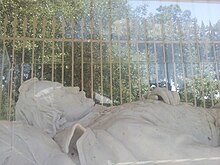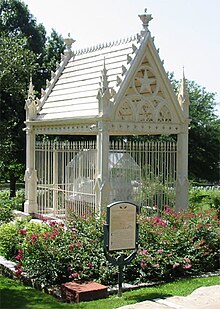
Albert Sidney Johnston served as a general in three different armies: the Texian Army, the United States Army, and the Confederate States Army. He saw extensive combat during his 34-year military career, fighting actions in the Black Hawk War, the Texas War of Independence, the Mexican–American War, the Utah War, and the American Civil War.
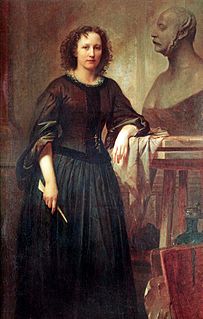
Franzisca Bernadina Wilhelmina Elisabeth Ney was a German-American sculptor who spent the first half of her life and career in Europe, producing portraits of famous leaders such as Otto von Bismarck, Giuseppe Garibaldi and King George V of Hanover. At age 39, she immigrated to Texas with her husband, Edmund Montgomery, and became a pioneer in the development of art there. Among her most famous works during her Texas period were life-size marble figures of Sam Houston and Stephen F. Austin, commissions for the Texas State Capitol. A large group of her works are housed in the Elisabet Ney Museum, located in her home and studio in Austin. Other works can be found in the United States Capitol, the Smithsonian American Art Museum, and numerous collections in Germany.
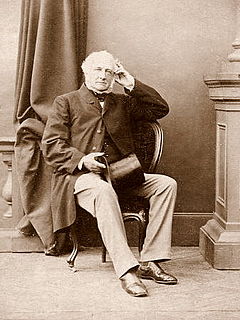
Baron Pietro Carlo Giovanni Battista Marochetti was an Italian-born French sculptor who worked in France, Italy and Britain. He completed many public sculptures, often in a neo-classical style, plus reliefs, memorials and large equestrian monuments in bronze and marble. In 1848, Marochetti settled in England, where he received commissions from Queen Victoria. Marochetti received great recognition during his lifetime, being made a baron in Italy and was awarded the Legion of Honour by the French government.

Pompeo Luigi Coppini was an Italian born sculptor who emigrated to the United States. Although his works can be found in Italy, Mexico and a number of U.S. states, the majority of his work can be found in Texas. He is particularly famous for the Alamo Plaza work Spirit of Sacrifice a.k.a. The Alamo Cenotaph, as well as numerous statues honoring Texan figures.

The 8th Texas Cavalry Regiment, (1861–1865), popularly known as Terry's Texas Rangers, was a regiment of Texas volunteers for the Confederate States Army assembled by Colonel Benjamin Franklin Terry in August 1861. Though lesser known than the Texas Brigade, famous for their actions during the Battle of Gettysburg, the 8th Texas Cavalry distinguished itself at several battles during the American Civil War. In four years of service, Terry's Texas Rangers fought in about 275 engagements in seven states. The regiment earned a reputation that ranked it among the most effective mounted regiments in the Western Theater of the American Civil War.

Littlefield Fountain is a World War I memorial monument designed by Italian-born sculptor Pompeo Coppini on the main campus of the University of Texas at Austin in Austin, Texas, at the entrance to the university's South Mall. Completed in 1933, the monument is named after university regent and benefactor George W. Littlefield, whose donation paid for its design and construction.
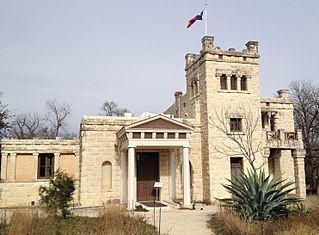
The Elisabet Ney Museum is a museum located in Austin, Texas, United States. It is housed in the former studio of sculptor Elisabet Ney and is dedicated to showcasing her life and works. There is a permanent collection of her portrait busts and personal memorabilia on display.

Liendo Plantation is an historic cotton plantation in Waller County, Texas, United States. Named after its original owner, José Justo Liendo, the plantation was purchased in 1873 by sculptor Elisabet Ney and her husband, physician Edmund Montgomery.

Albert Sidney Johnston is an outdoor sculpture depicting the general of the same name by Pompeo Coppini. The sculpture was commissioned in 1919 by George W. Littlefield to be included in the Littlefield Fountain on the campus of the University of Texas at Austin. It was installed on the university's South Mall in Austin, Texas from 1933 until its removal in 2017.

Stephen F. Austin is a statue of Stephen F. Austin by Elisabet Ney, originally modeled in 1893 and installed in 1905; it is part of the National Statuary Hall Collection in the United States Capitol in Washington, D.C., as one of the two statues from Texas. The other Texas statue, Sam Houston, is also by Ney and was produced in parallel. Another carving of Stephen F. Austin is displayed in the Texas State Capitol, where it was installed in 1903.
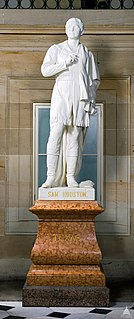
Sam Houston is a statue of Sam Houston by Elisabet Ney, originally modeled in 1892 and installed in 1905; it is part of the National Statuary Hall Collection in the United States Capitol in Washington, D.C., as one of the two statues from Texas. The other Texas statue, Stephen F. Austin, is also by Ney and was produced in parallel. Another carving of Sam Houston is displayed in the Texas State Capitol, where it was installed in 1903.

Lady Macbeth is a statue of the Shakespearean character Lady Macbeth by German American sculptor Elisabet Ney. The sculpture is a life-size full-length female figure rendered in marble. Completed in 1905, Lady Macbeth is one of Ney's last works and was regarded by the artist as her masterpiece. It is housed in Washington, D.C. in the Luce Foundation Center for American Art at the Smithsonian American Art Museum, which acquired the piece in 1998.
Albert Sidney Johnston (1803–1862) was a military commander who served in the armies of the Republic of Texas, the United States of America, and the Confederate States of America.

Arthur Schopenhauer is a sculpture of German philosopher Arthur Schopenhauer by sculptor Elisabet Ney. Completed in 1859, the piece is a portrait bust rendered in marble. The bust was modeled and carved in Germany, but it is now held by the Elisabet Ney Museum in Austin, Texas, United States.

Jacob Grimm is a sculpture of German philologist Jacob Grimm by sculptor Elisabet Ney. Completed in 1858, the piece is a portrait bust rendered in marble. The bust was modeled and carved in Berlin, but it is now held by the Elisabet Ney Museum in Austin, Texas.

Eilhard Mitscherlich is a sculpture of German chemist Eilhard Mitscherlich by sculptor Elisabet Ney. Completed in 1863, the piece is a portrait bust rendered in marble. The marble bust is now held by the Berlin's Natural History Museum, while the original plaster is displayed in Mitscherlich's mausoleum in Berlin's Alter St.-Matthäus-Kirchhof.
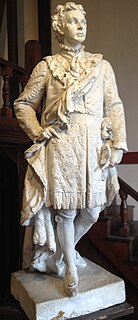
Ludwig II is a sculpture of King Ludwig II of Bavaria by sculptor Elisabet Ney. Completed in 1870, the piece is a portrait statue rendered in plaster. The statue was modeled and carved in Germany, but it is now held by the Elisabet Ney Museum in Austin, Texas; a marble version, completed by another sculptor, is installed in the Herrenchiemsee Palace in Bavaria.

Giuseppe Garibaldi is a sculpture of Italian revolutionary Giuseppe Garibaldi by German sculptor Elisabet Ney. Completed in 1866, the piece is a portrait bust rendered in marble. The portrait was modeled and carved in Italy, but it is now held by the Elisabet Ney Museum in Austin, Texas.
